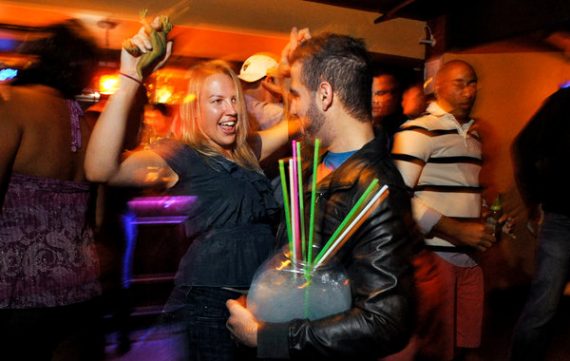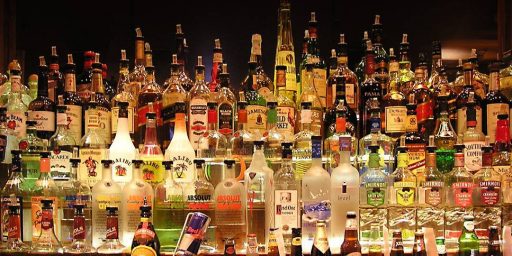College Bars Going Out of Style?
A wonderfully descriptive story in the New York Times Style section that's almost surely mere anecdote being touted as trend.
In “Last Call for College Bars,” the NYT Style section has another of those stories that simultaneously seem plausible and yet which is almost surely mere anecdote being touted as trend.
These days text messaging, Facebook and Foursquare make it possible to see if a bar is worth the trip (translation: who is there) without leaving the dorm. Meanwhile, location-based mobile apps like Grindr, which point to the nearest available candidates looking for sex or not-quite-sex, are helping dethrone college bars from their place as meat markets.
Students have spent so many hours pregaming (as in, getting as cost-efficiently drunk as possible, usually on hard liquor at a private party) that there is little need to waste money even on cut-price drinks, and they often don’t arrive at the bars until midnight or so, before the bars in Ithaca close at 1 a.m.
“Students don’t need bars to create a community the way they used to,” said Stephani Robson, a senior lecturer in the School of Hotel Administration at Cornell who specializes in restaurant psychology.
And it’s not just at Ivy League Cornell, where the libraries are open later than the bars, but in college towns across America like Iowa City, where at least four bars have closed since 2011.
Bars near Gettysburg College in Pennsylvania are so peripheral to Lanie Parr’s social life that she doesn’t know what time they close. That is not because she doesn’t drink. “We sometimes pregame even the pregame,” she said.
Pregames often are single sex, with men playing beer pong or video games, and women drinking vodka sodas or a peach-flavored Champagne called André and refusing to head out until they have captured the perfect photo, which they promptly post to Instagram and Facebook.
“You could have this really amazing night, but if you didn’t get a picture, it’s like it didn’t happen,” said Ms. Parr, 22, a senior at Gettysburg, whose friends often order designer outfits from the Rent the Runway Web site because incessant documenting makes wearing anything more than twice taboo. “It’s crazy how much pictures consume our lives. Everyone knows how to pose and how to hold your arm and which way is most flattering, and everyone wants the picture taken with their phone.”
That preamble tends to delay arrival time at bars, another factor in their decline. At Cornell, three Collegetown bars have closed in the last year, including the 71-year-old Royal Palm Tavern, a storied dive where students convened at “Palms o’clock,” meaning in time for one last drink.
“These kids today won’t pay even $2 for a drink,” said the former owner, Lenny Leonardo, as he cruised down a highway in Florida, where he retired in August. “They buy a bottle of Southern Comfort and show up in time to try to get laid. But they just end up throwing up in my men’s room, and I get reprimanded because it looks like I’m the one who let them get this drunk.”
This is wonderfully descriptive and enticing. At my age, these kids today stories are an easy sell. But this one is a little too cute.
Facebook and its ilk didn’t exist when I was an undergraduate; hell, the Internet didn’t exist when I was an undergraduate. So, I wouldn’t be surprised if the convenience of being able to asynchronously communicate with one’s friends and acquaintances is having ripple effects in other parts of the social lives of today’s college students and it’s plausible that the bar scene is being impacted.
On the other hand, were college students really spending every night in the bar drinking expensive drinks in halcyon days of 2003 before Facebook changed everything? Color me doubtful. For one thing, most undergrads are under 21. For another, most are broke. Nor, incidentally, has Facebook changed the economics. A bottle of Southern Comfort or a case of beer were cheaper than going to the bar—even if they were having specials—during the Reagan administration, too.
And, please, who are these girls who are renting designer outfits because they wouldn’t be caught dead Instagramming themselves in the same outfit twice? I encounter undergraduates often enough to know that they still dress like crap.
(As an aside, “Pregames often are single sex” is an excellent example of why the demise of hyphenation is a bad thing; I was well into that sentence before I realized it was about people of the same gender hanging out together rather that about students getting busy with the opposite sex.)







Lenny Leonardo is a pretty great name for a guy who owns a bar.
Of course, since most reporters are Ivy League graduates who never had to study statistics, it is always humorous that the reporters seem unable to look up data that would support their story.
1. How many college students are between the ages of 21-23?
2. What percentage of college students actualy live in a dorm or in an apartment near a campus. Considering that there are more undergraudates at the University of Minnesota than in the entire Ivy Leagues, maybe the idea that students preload in dorm rooms says more about the writer than about college students.
3. What is the impact of drinking on college students. Maybe the Ivy League graduates in the media do not realize that less than 50% of entering freshmen ever finish college, let alone hang about log enough to be frequenting college bars.
4. What percentage of college students are in fraternities or sororities? Maybe if the reporter realize how few students were in fraternities, the discussion of fraternities would have been left out.
I put this type of article in the same category of the annual NY Times story about how hard it is to get into Harvard when 99% of high school students could not care less.
Funny, the article skips over demographic trait changes in the “kids” today. Apparently, they are becoming savers and more conservative, at least in fiscal and economic issues. The current crop of college students have seen college cost explode while jobs opportunities expire. They have been said to be taking on more traits like the pre-boomer generation (1930-early 1940s) of responsibility and creative. So one might expect the party might slow down a bit. We might even see, in a couple years, that they’ve migrated to harder majors but those with job futures. You know, the ones that require effort and study rather than the after school party. It could simply be the kids are starting to take real advantage of there all expense paid sojourn of the mind and foregoing so much of the Club Med atmosphere
Super-Duper
Link please. Or are you just making shit up?
When I was in college the vast majority of people went out on Thursday and mostly just Thursday. Students who gathered to get wasted more often usually didn’t last that long in college. We did have a ton of bars in town within easy walking distance, and back in the 80’s students who were 18 could get into bars, they just weren’t allowed to drink (a rule easily gotten around but the bars didn’t care they were making good money).
My college age daughter tells me that most students just party in their rooms or in a few cases various houses/apartments off campus where older students live. She says very few people go out to bars. Probably cheaper to just buy your beer and gather in a room-and college students are often all about cheap.
@C. Clavin: He’s making shit up. For instance, U of M has 69,000 students — that’s the total of Cornell, Harvard, and Columbia (just 3 of the Ivies). Apparently SD should take his own advice, as he’s “unable to look up data that would support [his] story.”
I’m just shocked he didn’t mention how the one-party state was bringing this on.
@Just Me:
Cheaper, and also a consequence of the over 21 drinking laws and more stringent enforcement of those laws. If local authorities are actually serious about keeping the underage out, virtually all freshmen and sophomores and most juniors won’t be able to go to bars, and many seniors won’t go if, say, their junior boyfriend or girlfriend can’t join them.
After Obama turns us into Europe, we won’t have to deal with this nonsense, since the drinking age will be back to 18 where it belongs.
Back in the day (late eighties, early nineties) we “pre-gamed” not before going to the bars, but before going to the house parties. In fact, we rarely went to the bars because, like Mr. Joyner notes, we were broke.
Ten dollars would buy one a case of cheap beer and a pack of smokes. At the bar, ten dollars would be eaten up in less than twenty minutes. And on the few occasions that we did venture to the bars it was because we were mainly motivated by finding out where the after party would be.
Even the kids who did have some money would be at the parties because that’s where the action was.
I doubt social media has changed much of that.
Cheers.
Correction for the NYT, André simply a brand of sparkling wines and comes in more flavors than peach. The worst being Cold Duck.
The author has obviously never tried to throw a new years eve party on the cheap.
I’m with you. I was in undergrad when there wasn’t an internet, but I very rarely went to bars. When I did, it wasn’t to hook up, but because a group was going to specific place to celebrate something (game championship, end of exams, successful end of some club event).
The only other time we went to a bar, it was a restaurant that served $5 pitchers of margaritas on Tues. nights. My D&D group took over a table and played the old version (multisided dice and paper for mapping!) while noshing on nachos and margaritas watered down to the point of near-virginity.
Yes. I am a geek.
@ptfe:
The entire undergraduate enrollment at the Ivy leagues is around 60K (www.collegeresults.org) whereas the undergraduate enrollment at Arizona State are 54K, at Central Florida is 45K, 41K at Ohio State, 39K at Texas A&M.
Also, the reporter of the story is a Cornell Alumnist, and the NY Post has front page stories by Brown and Yale on the front page today. There are so many people who want to be reporters at the NY Times and the pay is not very much. So it lends itself to Ivy League graduates from wealthy families. http://www.halfsigma.com/2011/06/the-new-york-times-unauthorized-biography-series.html
I’m with the views of most here, but some schools have had reputations as party schools (with Playboy rankings of party schools): UofMD, San Diego Sate, Chico State, U of Iowa (direct correlation with the article). But those schools are the exception (and unfortunately the source of too many DC interns on the Hill – the ones with rich parents (my personal experience with a few of them, no stastics)).
John Belushi does not a college experience make. In my case I was under 21 for most of it, and went to a UC, a Research University, in a professional field (engineering). We’d often hit the college pub for “Fluid Friday” before Fluid Mechanics (we were all A and B students, and Professor PDA was cool with it), and would have big parties at the end of the quarter after the last final (I always seemed to have a late Friday final). But bars? Maybe 1x/month. Mostly finances, and under 21, or many of our friends were under 21.
The big difference I see is then with landlines and not everyone having an answering machine we planned several days out what we would be doing on a weekend, whereas today with cell phones, texting, social media, etc, it is more ad hoc except for major events (cough, Lady Gaga concert, whatever).